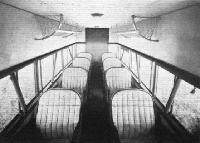
Savoia-Marchetti S.71 и S.72
Самолет S.71, впервые взлетевший в 1930 году, представлял собой трехмоторный свободнонесущий высокоплан смешанной конструкции, с закрытой кабиной и шасси с хвостовым колесом. Самолет был рассчитан на перевозку восьми пассажиров и четырех членов экипажа. Первые четыре S.71 были оснащены радиальными ПД Walter Castor, но остальные три самолета получили 370-сильные (276 кВт) ПД Piaggio P.VII. Обычно S.71 оснащались обтекателями на основных стойках шасси, обтекателем хвостового колеса являлся наплыв на фюзеляже.
Основным оператором самолета была итальянская "Societa Aerea Mediterranea" (SAM), выполнявшая рейсы между Римом и Бриндизи, а позднее вдоль побережья Адриатики до Албании. S.71 также эксплуатировались национальным авиаперевозчиком "Ala Littoria", образованным в 1934 году путем слияния компаний SAM, SANA и SISA.
Самолет S.72, отличавшийся от S.71 увеличенными размерами и усиленной конструкцией, создавался в качестве тяжелого бомбардировщика. Прототип (гражданская регистрация - I-ABMO, военный серийный номер - MM 219) взлетел в 1934 году, и хотя не был принят на вооружение ВВС, сначала использовался в качестве VIP-транспорта, совершая рейсы в итальянские колонии.
Летом 1935 года машину продемонстрировали в Китае, а затем подарили ее генералиссимусу Чанкайши. Китайцы заказали шесть серийных S.72, но они должны были собираться в Китае. Вероятно, большая часть из них была уничтожена во время японских налетов в конце 1937 года.
ТАКТИКО-ТЕХНИЧЕСКИЕ ХАРАКТЕРИСТИКИ
Savoia-Marchetti S.71
Тип: легкий восьмиместный транспортный самолет
Силовая установка: три радиальных ПД Walter Castor мощностью по 240 л. с. (179 кВт)
Летные характеристики: максимальная скорость 235 км/ч; потолок 6000 м; дальность полета 1600 км
Масса: пустого снаряженного 2900 кг; максимальная взлетная 4600 кг
Размеры: размах крыла 21,20 м; длина 14,00 м; высота 4,10 м; площадь крыла 60,00 м'
ТАКТИКО-ТЕХНИЧЕСКИЕ ХАРАКТЕРИСТИКИ
Savoia-Marchetti S.72
Тип: бомбардировщик/транспортный самолет
Силовая установка: три радиальных ПД Alfa Romeo (лицензионный вариант Bristol Pegasus) мощностью по 550 л. с. (410 кВт)
Летные характеристики: максимальная скорость 295 км/ч; потолок 8000 м; дальность полета 2000 км
Масса: пустого снаряженного 6800 кг; максимальная взлетная 12 800 кг
Размеры: размах крыла 29,68 м; длина 19,95 м; высота 5,50 м; площадь крыла 118,50 м2
Вооружение: до шести 7,7-мм пулеметов и одна 20-мм пушка, до 1000 кг бомб
Описание:
- Savoia-Marchetti S.71 и S.72
- Flight, May 1931
THE SAVOIA-MARCHETTI "S-71”
Фотографии
-
Aeroplane Monthly 1986-10 / J.Stroud - Wings of Peace
Регистрационный номер: I-AAYP [3] Three-quarter front view of the prototype Savoia Marchetti S.71, I-AAYP, commercial monoplane fitted with three 240 h.p. Walter "Castor" engines and accommodating eight passengers. It first appeared in 1930.
-
Aeroplane Monthly 1976-11 / Personal album
Регистрационный номер: I-AAYP [3] The Savoia Marchetti S.71, a three-engined transport aircraft accommodating a crew of three and eight to ten passengers, made its maiden flight in 1930. This particular example, I-AAYP, was powered by three 240 h.p. Walter Castor air-cooled radial engines which gave it a cruising speed of 111 m.p.h., and was one of six S.71s used by the Italian Societa Aerea Mediterranea, originally operating on their Rome - Brindisi service and later flying the entire Rome - Salonica route.
-
Мировая Авиация 230
Регистрационный номер: I-AAYP [3] Итальянская авиакомпания SAM использовала шесть S.71, включая прототип I-AAYP (на снимке). У самолета отсутствуют обтекатели, обычно устанавливавшиеся на основных стойках шасси.
-
Aviation Historian 32 / M.Wickstead - Italy's forgotten airlines (2)
Регистрационный номер: I-EOLO SIAI-Marchetti SM.71 I-EOLO was one of at least five absorbed into the Ala Littoria fleet from SAM, and served with ALSA until October 1939, when it was destroyed. The trimotor, which first flew in late 1930, was the first of SIAI-Marchetti’s multi-engined landplanes and could accommodate three crew and up to ten passengers.
-
Aeroplane Monthly 1986-10 / J.Stroud - Wings of Peace
Регистрационный номер: I-ABMO [2] The S.72 I-ABMO, in modified form, at Bangkok. The aircraft had accommodation for three crew and six passengers.
-
Мировая Авиация 230
Регистрационный номер: I-ABMO [2] Создававшийся как военный вариант самолета S.71, S.72 был крупнее предшественника, но не вызвал интереса у итальянских военных.
-
Flight 1931-05 / Flight
An interior view of the cabin of the Savoia-Marchetti "S 71."
-
Flight 1931-05 / Flight
Savoia-Marchetti "S-71" 3-240 h.p. Walter "Castor" Engines
- Фотографии







